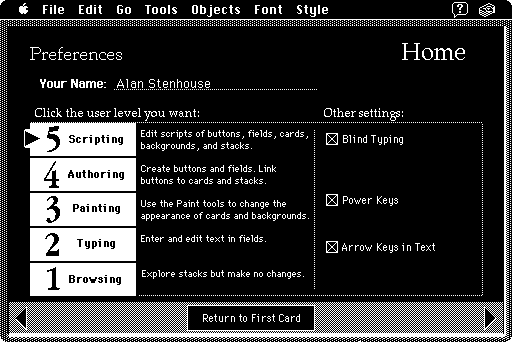I will be pleased to share my observations with you!
ARIA model
Hans van Driel in his research project “New media from a historical point of view” distinguishes four phases in developing “new media”:
- Amazement
- Resistance
- Imitation
- Authenticity
He called it the ARIA model.
Hypercard
Hypercard was developed in the early stages of personal computing, and with it’s “Stack and Cards / Rolodex metaphor” an imitation of the “paper world” we were used to for many, many years. Yet there were some features already, that are authentic to a (personal) computer, for example: hypertext-links to jump from one card to the other.
userLevel
As far as I know Hypercard is the only application that combines an “Integrated User Environment” and an “Integrated Developer Environment” into a seamless whole. Not just a seperate IDE and IUE. I would call Hypercard a prototype of an IUMDE.
The “user levels”, combined with dynamic menu items provided an increasing powerful environment from novice to expert, from information consumer to information producer to app-developer.
In the article on Hypercard at The Whole Code Catalog it says: “HyperCard users can move fluidly between browsing, typing, painting, authoring, and scripting a program. Hypercard saves all changes automatically, so lower-power levels are useful for when you don’t want to mess up a friend’s stack.”

An interesting way to make “on-boarding” very easy. Or to put it in other words: Hypercard had a gentle learning curve.
To me Hypercard is an excellent example of KISS = Keep it Smart and Simple. Things will get complicated soon enough anyway …
Obsidian
Many years later the developers of Obsidian draw lessons from the past to start creating a new kind of application for “Personal Knowledge Management”.
And may I just voice my appreciation for making it available free for personal use!
I see it as a small next step toward the authentic use of the power of current networked computers, which are able to show graphics like the dynamic graphs in Obsidian.
In my view we are only starting to use a fraction more power, that lies dormant in the hardware we have at our disposal. Many times the tools I use run almost idle on my desktop, or in the palm of my hands.
So I regard both Hypercard and Obsidian as prototypes pointing to a direction of what applications of the future might look like, and do. In my opinion the “Information Age” hasn’t even started yet…
Just imagine
I have been experimenting with Obsidian for a few weeks now, and I feel the same enthusiasm I had when discovering Hypercard.
Both are meant to empower the individual in seemingly very different ways.
Yet underneath the surface I see similarities too. Things like
- core application, and plugins
- easy learning curve,
- automatic save,
- my way, not the application getting in the way.
Just imagine combining features from Hypercard and Obsidian, staying true to the underlying basic design principles of both: what an exciting user experience we could create!
In my imagination I already see new prototypes appearing on the horizon …
“The best way to predict the future is to invent it.” - Alan Kay
Thanks for reading my thoughts! Maybe it helps spark brilliant ideas. Have a nice day!


 How about you?!
How about you?!